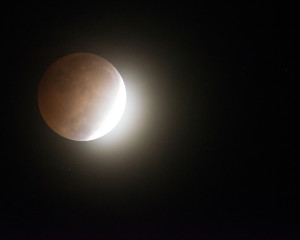A Total Eclipse of the Moon
Get set for one of the most dramatic and beautiful of all astronomical events.
By Steve Kates
A scorching August leads us to September and hopefully cooler weather. As the heat slowly retreats, the night skies of August and September offer up some celestial gems.
Get set for one of the best meteor showers of the entire year as the annual Perseid meteor shower peaks on the night of Aug. 12. With the special added bonus of no moonlight that night, it promises to be one of the best years to see this great shower, as long as the summer monsoon doesn’t kick into high gear.
The tiny fragments of meteor dust from Comet 109P/Swift-Tuttle have been orbiting the sun for many years. Now, each August, they line up like tiny projectiles and enter the orbital path of the Earth during early to mid-August, providing us with a decent “shower” of comet debris. The peak of this main event occurs on the aforementioned night into the morning hours of Aug. 13. Look low into the northeastern sky right around 11 p.m. on the 12th, and keep your vigil going until dawn. The radiance of this shower lies in the constellation of Perseus and will be high in the northern sky near dawn.
The highest number of meteors will be seen from 2 a.m. until dawn as the Earth plows into the deeper and denser regions of comet debris. Expect to see well over 50 meteors per hour under these dark and moonless skies.
Perseids typically travel at the speeds of some 37 miles per second, providing us with some great special effects, as they seem to burn up right before your eyes. Digital cameras can capture the wonders of this great meteor shower, too!
Meanwhile, the moon is at last quarter on Aug. 6, with new moon on the 14th. The moon then waxes and return to first quarter on the 22nd, with the Full Sturgeon Moon on the 29th. In August, we lose Venus to the glare of the sun, with Jupiter fading as well. Saturn is only major planet that we can easily view. It appears high in the south at sunset.
September skies bring us the annual equinox, but the major sky event will be the total lunar eclipse, or Blood Moon, on the night of Sept. 27. This will be the last major total lunar eclipse of this tetrad. The sunset on the 27th is at 6:18 p.m., with the moon rising at 6:14 p.m. The moon will rise as the partial phases of the eclipse begin, with totality starting at 7:11 p.m. and lasting some 64 minutes until around 8:23 p.m. local Arizona time. The moon should be easy to see, and this eclipse will be a delight for all to view with the naked eye—don’t miss it!
This is also the date of the Harvest Moon. Before the moon puts on its big sky show in September, it reaches last quarter on the 5th, new moon on the 13th, and then on to the Full Harvest Moon on eclipse night, the 27th.
For planets, Mercury is well placed in the evening sky on the 4th. Venus returns to the morning sky and is close to the moon on the 10th. Saturn remains the main planet in the evening sky, low in the southwestern sky at sunset. The change of seasons occurs with the autumnal equinox on the 23rd and hopefully signals an end to the heat and monsoon activity, too.
If you’re interested in seeing the Perseid meteor show with friends and family, why not join me, Dr. Sky, at our Meteor Madness event at the Lost Dutchman State Park on Aug. 12 at 9 p.m. for a great night under the stars. For more information on this event, call the Friends of the Lost Dutchman State Park at (480) 748-8019 for details.
Lunar Eclipse Facts:
The total lunar eclipse of Sept. 27 is the last in this tetrad of four lunar eclipses
The Sept. 27th total lunar eclipse is also the Full Harvest Moon of 2015.
The next total lunar eclipse visible in Arizona will be Jan. 21, 2019
DID YOU KNOW
A total lunar eclipse is one of the most dramatic and easiest to view of all astronomical events. During a total lunar eclipse, the sun, Earth, and moon form a line of space, with the Earth’s showdown falling on the face of the moon. Total lunar eclipses are safe to view with your bare eyes, and no special equipment is needed.
The next major total solar eclipse visible in most parts of the United States will take place Aug. 21, 2017.
Related posts
Leave a Comment
You must be logged in to post a comment.







